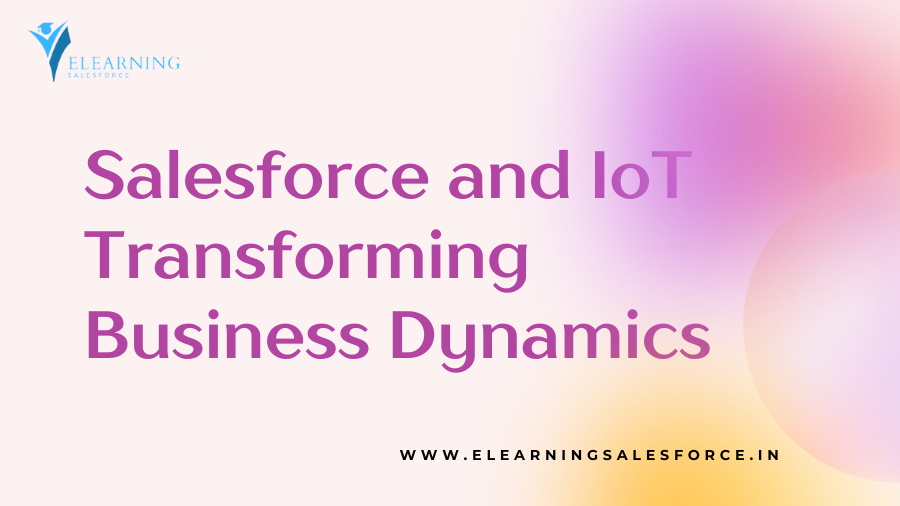In the ever-evolving landscape of technological advancements, the integration of Salesforce and the Internet of Things (IoT) stands out as a game-changer. This dynamic duo doesn’t just connect devices; it transforms how businesses operate, interact with customers, and make data-driven decisions.
I. Introduction
A. Brief Overview of Salesforce and IoT
Salesforce, renowned for its Customer Relationship Management (CRM) solutions, meets the Internet of Things (Io T), a network of interconnected devices sharing data. The integration of these two technologies reshapes how businesses manage and utilize vast amounts of data generated by IoT devices.
B. Significance of Their Integration in Modern Business
As businesses navigate the digital era, the synergy between Salesforce and Io T becomes crucial. It’s not just about collecting data; it’s about turning that data into actionable insights, optimizing operations, and revolutionizing customer experiences.
II. Unpacking Salesforce and IoT
A. Understanding Salesforce in a Nutshell
Salesforce is more than a CRM platform; it’s a comprehensive suite of tools designed to streamline business processes, enhance customer relations, and drive growth. Its cloud-based solutions provide a scalable and flexible foundation for various industries.
B. Demystifying the Internet of Things (IoT)
IoT involves connecting devices—ranging from everyday objects to industrial machines—to the internet, enabling them to send and receive data. It’s the backbone of a connected world, where devices communicate seamlessly, generating a wealth of valuable information.
C. How Salesforce and IoT Converge
The convergence of Salesforce and IoT means that businesses can harness the power of real-time data from connected devices. This synergy creates opportunities for smarter decision-making, personalized customer experiences, and operational excellence.
III. Use Cases and Benefits
A. Optimizing Customer Relationship Management (CRM)
Salesforce and IoT integration enable businesses to gather real-time insights into customer behavior. This data, coupled with Salesforce’s CRM capabilities, allows for highly personalized interactions, enhancing customer satisfaction and loyalty.
B. Enhancing Data-driven Decision Making
The influx of data from IoT devices empowers businesses to make informed, data-driven decisions. Salesforce’s analytics tools provide actionable insights, guiding strategic initiatives and improving overall business intelligence.
C. Improving Operational Efficiency
By automating processes through Io T-connected devices, Salesforce helps businesses optimize operations. From supply chain management to inventory tracking, the integration enhances efficiency and reduces operational costs.
IV. Integration Process
A. Steps to Integrate Salesforce with IoT
The integration involves connecting IoT devices to Salesforce’s cloud, leveraging APIs and IoT platforms. A systematic approach ensures a seamless and effective integration, allowing businesses to harness the full potential of both technologies.
B. Key Considerations for a Successful Integration
Considerations include data security, compatibility of IoT devices, and the scalability of the integrated system. A well-thought-out strategy ensures a successful and sustainable Salesforce and Io T integration.
C. Real-world Examples of Successful Integrations
Several companies across industries have successfully integrated Salesforce with Io T, realizing tangible benefits. Case studies showcase how businesses have improved operations, enhanced customer experiences, and gained a competitive edge.
V. Impact on Customer Relations
A. Personalizing Customer Experiences
The integration allows businesses to create highly personalized customer experiences. From personalized recommendations to proactive issue resolution, Salesforce and IoT redefine how companies engage with their customers.
B. Predictive Analytics and Customer Insights
IoT-generated data, when analyzed through Salesforce’s predictive analytics, provides deep insights into customer preferences and behavior. This enables businesses to anticipate needs and tailor their offerings accordingly.
C. Building Customer Trust through Transparency
The transparent nature of Salesforce and IoT data ensures customers are aware of how their information is used. This transparency builds trust, a crucial element in sustaining long-term customer relationships.
VI. Streamlining Business Operations
A. Automation of Processes
Connected devices automate routine tasks, reducing the burden on human resources. Salesforce’s automation capabilities further streamline processes, contributing to overall operational efficiency.
B. Efficient Resource Management
IoT data allows businesses to monitor and manage resources efficiently. Whether it’s energy consumption or inventory levels, the integration provides real-time insights for better resource utilization.
C. Accelerating Time-to-Market
With streamlined operations and data-driven decision-making, businesses can bring products and services to market faster. This agility is a significant competitive advantage in today’s fast-paced business environment.
VII. Addressing Security Concerns
A. Ensuring Data Security in IoT
Security is a top concern in IoT, given the vast amount of data exchanged between devices. Salesforce’s robust security features, including encryption and access controls, ensure the integrity and confidentiality of IoT data.
B. Salesforce’s Role in Securing IoT Data
Salesforce’s commitment to data security extends to IoT integration. With continuous monitoring, threat detection, and regular updates, businesses can trust Salesforce to safeguard their critical IoT data.
C. Building a Robust Security Infrastructure
A proactive approach to security involves implementing best practices, regular security audits, and employee training. A robust security infrastructure is essential for maintaining the integrity of the Salesforce and IoT ecosystem.
VIII. Future Trends and Innovations
A. Emerging Trends in Salesforce and IoT Integration
The collaboration between Salesforce and IoT continues to evolve. Emerging trends include edge computing, AI-driven insights, and the integration of augmented reality for enhanced user experiences.
B. Innovations Shaping the Future of Connected Business
As technology advances, so does the potential for innovation in connected business ecosystems. From smart cities to intelligent manufacturing, Salesforce and IoT are at the forefront of shaping the future of interconnected industries.
IX. Case Studies
A. Success Stories of Companies Leveraging Salesforce and IoT
Examining success stories provides real-world examples of the benefits derived from Salesforce and IoT integration. These case studies showcase the diverse applications and positive outcomes for businesses.
B. Quantifiable Benefits and Outcomes
Businesses that have integrated Salesforce and IoT can quantify the benefits in terms of increased revenue, cost savings, and improved customer satisfaction. These measurable outcomes validate the value of the integration.
X. Advantages Over Traditional Systems
A. Comparing Salesforce and IoT Integration to Conventional Solutions
Traditional systems often lack the real-time insights and automation capabilities offered by Salesforce and IoT integration. The speed, accuracy, and scalability set this integration apart from conventional solutions.
B. Unique Features and Competitive Edge
Salesforce and IoT integration bring unique features to the table, such as predictive analytics, personalized customer experiences, and efficient automation. These features contribute to a competitive edge in the market.
XI. Overcoming Resistance and Challenges
A. Addressing Employee Resistance to Technological Change
Employee buy-in is crucial for the success of any technological integration. Communication, training, and highlighting the benefits help overcome resistance and foster a culture of innovation.
B. Mitigating Challenges in Implementing Salesforce and IoT Solutions
Challenges may include technical complexities, data privacy concerns, and initial implementation costs. Mitigating these challenges involves careful planning, collaboration with stakeholders, and a phased implementation approach.
XII. Scalability and Adaptability
A. Growing with the Business
One of the significant advantages of Salesforce and IoT integration is its scalability. As businesses grow, the system can seamlessly scale to accommodate increased data volumes and device connections.
B. Adapting to Evolving Business Needs
The dynamic nature of business requires systems that can adapt to changing needs. Salesforce and IoT integration provide the flexibility needed to accommodate evolving business requirements and technological advancements.
XIII. User-Friendly Interfaces
A. Making Complex Technologies Accessible
While the technologies involved may be complex, user-friendly interfaces ensure that employees can interact with the integrated system without requiring extensive technical expertise. Intuitive design promotes user adoption.
B. Ensuring User Adoption and Satisfaction
A focus on user satisfaction is essential for the successful implementation of any technology. Training programs, user support, and feedback mechanisms contribute to high levels of user adoption and satisfaction.
XIV. Conclusion
A. Recap of Key Points
The integration of Salesforce and IoT is more than a technological evolution; it’s a transformative journey for businesses. From enhancing customer relations to optimizing operations, the benefits are diverse and impactful.
B. Encouragement for Businesses to Embrace Salesforce and IoT Integration
As businesses navigate the complexities of the digital age, the integration of Salesforce and IoT emerges as a strategic move. Embracing this transformative technology is not just an investment in the present but a commitment to a future where connectedness and data-driven insights drive success.
Frequently Asked Questions
- Is Salesforce and IoT integration only suitable for large enterprises?
- No, businesses of all sizes can benefit from the integration, adapting it to their specific needs and scale.
- How does the integration contribute to personalized customer experiences?
- By leveraging IoT data, Salesforce enables businesses to understand customer preferences and behavior, facilitating personalized interactions.
- What steps should businesses take to ensure the security of IoT data within Salesforce?
- Implementing encryption, access controls, and regular security audits are key steps to ensure the security of IoT data within Salesforce.
- Can Salesforce and IoT integration adapt to future technological advancements?
- Yes, the integration is designed to be scalable and adaptable, allowing businesses to incorporate future technological advancements seamlessly.
- How does Salesforce and IoT integration compare to traditional data management systems in terms of efficiency?
- The integration offers real-time insights, automation, and scalability, providing efficiency levels that often surpass traditional data management systems.




